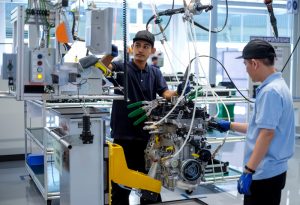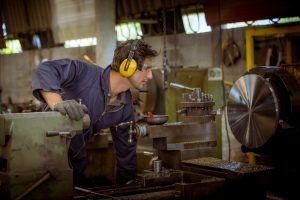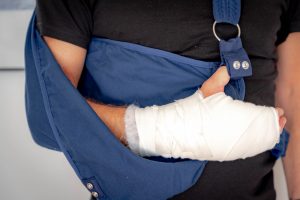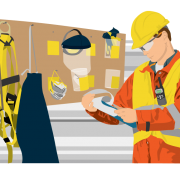Working safely around machinery
“Any interaction with machinery has the potential to cause injury to a worker.”
There is no doubt that technology and the use of machines have significantly impacted the way we do work. A good example is the use of machines in the manufacturing sector where nowadays it is very common to find automated mass assembly lines replacing workers.

Nevertheless the past two centuries of automation and technological progress did not make human labour obsolete1. Machines and automation does give an advantage when it replaces humans in performing repetitive, routine and even hazardous or dangerous work. Yet there is still a challenge when substituting machines for workers in tasks requiring flexibility, adaptability, problem solving, creativity, judgement and common sense. Therefore, there is still a need for humans to interact with machines used in manufacturing, especially during the design and installation phase, as well as during monitoring, maintenance, cleaning and repairs.

High rate of workplace fatality involving machinery
Any interaction with machinery has the potential to cause injury to a worker. Tragically there is still a high rate of incidents involving machinery in Australia. The latest data from 2020 showed 13 fatalities involving workers being trapped by moving machinery2. Therefore it is extremely vital that workers and their supervisors understand the hazards involved with the machines they work with and apply appropriate safety measures to control the risks.

Most common types of accident involving machines
The most common mechanical hazards for operating heavy machinery and equipment, as well as its associated injury risk3, are as described below.
| Hazard | Injury risk to operators |
| Sharp edge – moving or stationary | Cutting or puncturing |
| Scissor or shear action | Severing |
| Rotating shafts, pullies, sprockets and gears | Entanglement or degloving |
| Hard surfaces moving together | Crushing |
| Cable or hose connections | Slip, trip and falls |
Workplace activities involving machines which can pose a high risk includes workers being required to:
- Place their hands close to the mechanism of the machinery and equipment that does the work, and may be injured if caught or trapped by moving parts
- Make adjustments to the mechanism of the machinery whilst it is in motion
- Clear away scraps or sort items coming out of the machinery whilst it is in motion
- Access machinery from the top, sides or underneath
- Work on machinery at a height or over the machinery to connect services such as electricity, air or water
- Repair or maintain machinery which requires disabling or removing normal safety systems to access the mechanism of the machinery.

Degloving injuries
When a body part is caught on something and pulled away violently, the skin and soft tissue can peel back, revealing a large portion of flesh. Any part of your body covered by the skin can become degloved, however the most common injuries occur in the hands, feet, legs and arms4. Degloving injuries happen frequently during incidents involving heavy machinery with conveyor belts components.

Another common degloving injury is a ring avulsion injury. It occurs when a ring you are wearing on your finger is suddenly pulled away with a strong force. This can result in severe injury ranging from soft tissue laceration to complete amputation5. It usually involves only 1 digit finger and most commonly occurs when a wedding band is caught on machinery or a protruding object.
Controls to ensure worker safety around machinery
Employers should apply the hierarchy of control when managing the risk of workers being injured by the machines they work with, as shown below:
- Elimination or substitution – Extremely dangerous machines should be eliminated from use whenever possible or substituted with another safer machine.
- Isolation or separation – Where worker contact or access to the hazard is prevented. The main types of isolation from the hazard includes separation by distance (where a worker cannot reach the hazard due to distance) , barrier and time. A common example of barrier control is installing guarding around the machine.
- Using engineering controls such as installation of simultaneous two-handed operation buttons where the hazardous machine mechanism cannot occur until both worker’s hands are clear of the danger area (when pressing both buttons simultaneously).
- Administrative controls including effective supervision, instruction and training on safe operation of machines.
- Personal Protective Equipment (PPE) such as the use of gloves to protect hands from being caught in rotating machine mechanism.

An example of guarding around a machine
Note that the use of Administrative and PPE controls are low order controls and should not be used as the sole means of control, but as a last order after the higher order controls have been implemented first.
Machine guarding can be installed to:
- Prevent bodily access to hazards such as dangerous moving parts, rotating shafts or rotating end drums of belt conveyors
- Contain ejected parts, off-cuts or swatch which can pose a projectile hazard to workers
- Form part of a safe working platform for workers

Emergency stop buttons should be installed on all machines as part of engineering controls. Emergency stops do not control the risks; however it could minimise the harm to workers during an emergency situation. Emergency stops should be located within easy reach of workers, be highly visible, and should not be used as on/off switches.

Working safely around machines
Employers should have a Work Health and Safety (WHS) Management System in place to ensure their workers stay safe around machines. The main components of a WHS system are:
- A WHS Manual which is a handbook detailing how every aspect of safety will be addressed
- A safety Induction where workers are instructed into key WHS information
- Safe Work Instruction documents to train workers on all machines they will be working with, the safety system installed in each one and procedures to verify when a machine is working as expected
- Forms such as a workplace inspection checklist to identify all hazards as well as to review control measures to ensure they remain effective.

Checklist and regular safety audits are crucial to ensure safety systems are implemented correctly by workers
A WHS Management system is like a lock that protects you and your workers in the workplace. However every lock needs a key, and as the employer you are the key to ensuring the presence of an appropriate WHS Management System in your workplace.
Citations
- Autor, D., 2015, ‘Why Are There Still So Many Jobs? The History and Future of Workplace Automation’, Journal of Economic Perspectives, Vol 29, No. 3, p3-30.
- Safe Work Australia, ‘Key Work Health and Safety Statistics, Australia 2021”, https://www.safeworkaustralia.gov.au/resources-and-publications/statistical-reports/key-work-health-and-safety-statistics-australia-2021, accessed on 22 June 2021.
- Workplace Health and Safety Queensland, 2019, ‘Guide to Machinery and Equipment Safety’, Queensland Government.
- Dr. Brennan, D., 2021, ‘What is a Degloving Injury?’, WebMD, https://www.webmd.com/skin-problems-and-treatments/what-is-a-degloving-injury, accessed on 21 June 2022.
- Jones, M., Gujral, S., 2016, ‘Ring Avulsion Injuries’, Eplasty, Vol. 16, https://www.ncbi.nlm.nih.gov/pmc/articles/PMC4753839/, accessed on 21 June 2022.











